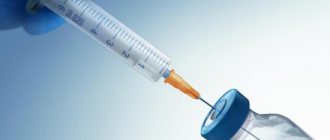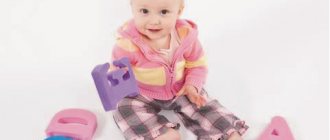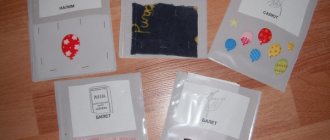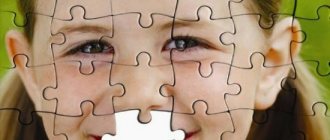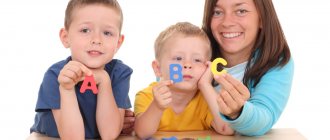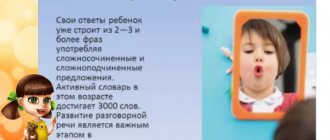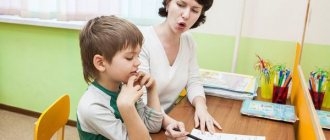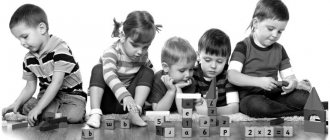Phonetic-phonemic underdevelopment of speech is characterized by a delay in speech development, primarily expressive speech. This condition is often associated with underdevelopment of the cortical parts of the brain, which take on a mature “look” as the baby grows older. If a child’s problems persist after three years, he may be diagnosed with “speech development delay” (SDD). In this case, active speech therapy work begins, aimed at correcting the disorders. Additionally, drugs for speech development can be used: nootropics and drugs that improve the condition of nerve cells.
Information about the disease
The child’s speech development goes through a number of successive stages, which are closely monitored by the pediatrician and parents. As you grow older, you observe a gradual enrichment of your vocabulary, the formation of correct pronunciation and understanding of what others say. It is believed that a child’s speech development continues actively until the age of 3. During this time period, the child enters kindergarten, where he begins to actively communicate with peers and teachers.
At the age of 3 years and older, a diagnosis of speech delay may be made. Doctors believe that this pathology is manifested by a simultaneous violation of all parts of speech: grammar, phonetics and vocabulary. As a rule, suspicions about the presence of a disorder arise earlier, but RDD is diagnosed only after reaching the age of three. Until this time, a speech therapist actively works with the child, which in most children leads to the formation of normal speech.
In the absence of correction, mental retardation can cause the development of dysgraphia and dyslexia, characterized by impairments in writing and reading, respectively. This, in turn, negatively affects the child’s memory, attention, as well as the learning process in kindergarten and school.
Delayed speech development is a consequence of a functional disorder in the maturation of the cortical parts of the brain and the articulatory apparatus. In this regard, therapy for such a condition is always carried out jointly by a pediatrician and a speech therapist using medications, speech therapy exercises and other methods.
Why may there be delays in speech development in children?
Firstly, this may be a general inhibition of development or even a mild degree of mental retardation. Such a diagnosis can only be made by a qualified doctor.
Secondly, the whole issue may be in the hearing aid - if a child hears poorly, then he will, accordingly, have difficulty understanding what others are saying. This reason must be identified and eliminated first.
Thirdly, children who are premature and weakened by excessive illness take longer to develop and speak less and worse than their peers.
Fourthly, children with significantly developed intelligence do not speak for a long time, but then there is a sharp breakthrough that completely covers the long days of silence. So, there is always the possibility that the child is a child prodigy.
Fifthly, the child in the family may simply not be given attention or spoken to, which is why he has a small amount of learned words. This has its own scientific name - “Mowgli syndrome”.
Sixthly, the child may be in such conditions that he doesn’t seem to need to speak - he is understood at a glance. The family tries to immediately understand what exactly he wants, focusing on simple “aha” and “boo.”
Necessary treatment
An effective approach to eliminating speech disorders is comprehensive, including speech therapy sessions, medications and improving the social situation in the family. A psychologist and psychotherapist works with the child’s parents and the child himself. This allows you to improve the quality of communication in the family and guide parents towards regular communication.
A common cause of RRD is articulation disorder associated with pathology of the tongue, teeth, lips or jaws. To eliminate them, special gymnastics are performed, aimed at improving the functioning of the articulatory apparatus. Additionally, speech therapy massage is used to relieve tension from facial and chewing muscles. Physiotherapy is of additional importance in therapy: electrical stimulation, LOGO+ and other techniques. They can help improve the function of the cortical and subcortical parts of the brain, eliminating speech defects.
Improving metabolic processes and protecting nerve cells from damaging factors is possible with the use of drugs from various pharmacological groups. Only a specialist should select drugs, since they all have certain indications and contraindications for their use.
Goals of drug treatment
The main goal of using medications in the treatment of speech delay is to improve the nutrition of nervous tissue. It is known that neurons actively metabolize glucose, obtaining energy and essential nutrients from it. Stimulating metabolic processes allows you to increase cell activity and their functional maturity. The main group of drugs used for this are nootropics.
Children with functional disorders of the cortical parts of the brain may show signs of attention deficit hyperactivity disorder. To correct the symptoms in this case, it is recommended to take Picamilon and its analogues. In case of increased lethargy in children, Ceraxon and similar medications should be chosen.
It is important for parents to understand that the prescription of medications for the treatment of RRD is of an auxiliary nature. Even good medications do not exclude regular and long-term speech therapy sessions, but only ensure acceleration of the formation of correct speech.
Boom stimulation
- Draw your child's attention to your face. Call him, blow, cluck to the baby, waiting for his gaze.
- Talk to your baby, conducting a kind of dialogue with him. When making sounds reminiscent of humming or cooing, pause to give your baby the opportunity to respond to you.
- Repeat the sounds your baby makes. Remember that a “talking face” is the most powerful stimulus for attracting a child’s attention. At this age, children enjoy smooth, melodious speech. They listen carefully to the intonation, not yet understanding the meaning of the speech.
- Be attentive to your child's signals; perhaps he also wants to communicate with you. This is evidenced by his look, smile, cooing sounds.
- While talking to the baby, tickle him and stroke him. Your speech and your smile, combined with tactile-motor stimulation, will help your baby smile at you. In addition, such “inhibition” stimulates the revitalization complex.
- If a child looks away, turns away, or puts his hands behind his head, this is a signal that he is tired and you need to take a break from communication.
Main groups of drugs
All tablets for speech development in children are usually divided depending on their chemical structure and the effect they have on the brain. Doctors identify the following groups of drugs for the treatment of cerebral cancer:
- Analogues of gamma-aminobutyric acid (GABA) - Picamilon, Pantogam, etc. GABA is an inhibitory neurotransmitter that ensures the normalization of nerve impulses in the brain. Recent scientific research shows that GABA-based drugs improve the uptake of oxygen and glucose into neurons, which has a positive effect on their functioning. Pantogam and its analogs are recommended for children with manifestations of hyperactivity syndrome and other conditions accompanied by increased excitability of the central nervous system. Many of these products are available in the form of drops, which makes them easier to use in childhood.
- Products containing pyritinol (Encephabol, Cerebol) are active neuroprotectors. They have a membrane-stabilizing effect and block the formation of free radicals that can destroy nerve cells and their internal structures. In addition, thanks to this action, the drugs increase the viability of neurons during hypoxia, that is, lack of oxygen. Available in the form of tablets and suspensions.
- Ceraxon is a nootropic with a stimulating effect on the central nervous system. The drug contains citicoline as an active component, which increases the energy supply of nervous tissue and stimulates the restoration of the cell membrane of neurons. Additionally, it has an anti-edematous effect, reducing the amount of intercellular fluid in the brain. Ceraxon can be taken by children suffering from mental retardation with signs of central nervous system inhibition, including autism.
At the age of 1-2 years, medications are not used for functional delay in speech development, since the condition is easily relieved with the help of speech therapy sessions.
These drugs are highly effective and are included in the ranking of the most frequently prescribed drugs to eliminate speech defects in childhood.
Stimulating babble
- Play with your baby while sitting face to face. To do this, you can use a special chair with an inclined back (children's chaise longue, car seat). Sitting comfortably, your child will be happy to play with you.
- Repeat after your child the sounds he makes. Pause to give him the opportunity to respond to you.
- While your baby is making long vowel sounds, place your index finger under his lower lip and help him close his lips. Repeat these movements so that the child pronouncing a gets the syllables ba-ba-ba.
- Encourage your baby to put comfortable toys in his mouth. They create additional stops in the mouth, which also stimulates the appearance of syllables with consonants.
- Use a combination of chains of movements with chains of syllables: when pronouncing syllables, for example, ba-ba-ba, ma-ma-ma, jump with the child. To do this, you can sit the child on a large ball, another springy surface, or simply on your lap.
- Shake and toss the baby, this usually makes him laugh and shout loudly.
- Imitate the babble of a baby. Try to fully maintain the pace, timbre and pitch of the child’s speech. When pronouncing labial sounds and syllables, draw the child's attention to your mouth. Pause to give your child time to repeat the sounds.
- If possible, record the babbling speech of another child and let your baby listen to it. If your child has periods of active vocalization, usually in the morning, record your child's “speech” and give it to him to listen to.
Finger and gesture games
Scientists have found that in the brain, the nerve centers responsible for the movements of the fingers and hands are in close proximity to the areas of the brain responsible for the development of speech. Therefore, it is simply necessary to promote the active actions of the baby’s fingers and hands. Finger games are wonderful helpers in this matter.
In addition to funny rhymes, it is very useful to learn simple gestures with your baby in the meantime, for example:
- To the question “How old are you?” We show the index finger - “1 year old”;
- We shake our index finger “Ay-ay-ay”;
- We show “yes” and “no” by moving our heads;
- We show “thank you” with a nod of the head;
- To the question “How are you doing?” We show our thumb - “Wow!” ("Great!")
- We depict how the bear walks (feet shoulder-width apart, trampling from foot to foot);
- We depict how a bunny jumps (arms in front of the chest, hands down, jump);
- We depict how a fox walks (wiggle its butt);
- We depict how a wolf clicks its teeth (we open and close our mouth wide, clicking our teeth);
- We depict how a butterfly flies (waving our arms, running around the room);
- We depict how an airplane flies (arms motionless to the sides, we run around the room);
- We depict how a duck walks (we move on our haunches).
- As we approach two years of age, we begin to learn a new answer to the question “How old are you?” and we train to show the index and middle fingers at the same time - “2 years old”. The same finger figure can be called “Bunny”
Breathing game exercises aimed at training speech exhalation
One of the very first and very useful articulation exercises that a one-year-old baby can handle is blowing. So, how can you master the blowing skill:
- The wheel burst. First, we clasp our hands in a circle in front of us, depicting a wheel. Then, as you exhale, we begin to slowly cross our arms (so that the right hand rests on the left shoulder and vice versa) and say “sh-sh-sh” - the wheel deflates.
- Pump. Next, we invite the child to pump up the deflated tire. We clench our hands in front of our chest into fists, as if we were holding a pump. We lean forward and lower our hands down, accompanying our actions with the sound “ssss”, repeat several times.
- Loud quiet. We pronounce a sound loudly and quietly. For example, first we pretend to be big bears and say “Uh-uh,” then we pretend to be little bears and say the same thing, only quietly.
- Woodcutter. First, we put our hands together (as if we were holding an ax) and raise them up. Then we sharply lower them down, bending over and saying “uh.” We repeat several times.
- Wizard . First, we wave our hands and hold them at the top. Then we smoothly lower it, pronouncing the syllables: “M-m-m-a”, “M-m-m-o”, “M-m-m-u”, “M-m-m-y”.
- We blow on pieces of paper napkin, cotton wool, through a straw into water - we blow bubbles
- We blow out the candles - of course, under the strict supervision of adults
- We make aids on strings - paper butterflies, clouds, snowflakes, and blow on them
- We launch boats with paper sails from plastic cups into a bowl of water and blow into the sails
- We show the “breeze” - we blow on each other
- Blowing feathers and ping pong balls off the surface
- We blow through a straw into a bottle covered with a lid with foam balls.
Articulation exercises
Articulation exercises can be practiced from about 1.5 years of age, and some things may be possible even earlier:
- "Hide and seek." First we show our tongue - stick it out as far as possible, then hide it, repeat this several times.
- "Watch." Move the tongue from side to side - left and right.
- "House". We declare that the baby’s mouth is home. The mother gently taps her finger on the cheek: “Knock, knock,” and the baby’s mouth opens. We say: “Bye! Bye!” and his mouth closes.
- "Yummy". We open our mouth slightly and lick ourselves: first we run our tongue along the upper lip, then along the lower lip.
- "Balloon". We puff out our cheeks and burst them with our fingers;
- "Fence". We show our teeth (“bar our teeth”) and say that the tongue is hidden behind the fence.
- “Brushing our teeth.” We show the teeth again, then with the tip of the tongue we slide first along the upper teeth, then along the lower ones.
- "Horse". We “clop” our tongues like horses.
- “They made a mistake.” We stand together in front of the mirror and begin to express ourselves: smile widely, frown, stretch out our lips.
Onomatopoeia with repetitions is useful to do at different tempos:
How does the car sound? Beep beep! How does a cow moo? Moo-moo-moo! How does the drum beat? Ta-ta-ta! How does mom sing a song? La-la-la! How does a chicken peck grain? Kluk-klu-klu! How does the pipe play? Doo-doo-doo!
Games for speech development
You can sculpt from plasticine, play with cereals, buttons and pebbles, and paint with your fingers. You can accompany these activities with rhymes in which the baby must help the mother. These are the well-known “geese-geese”, the clumsy bear and short poems and nursery rhymes.
Many children like children's songs, which they try to repeat with pleasure. Play songs for your child to go with him. After such regular classes, speech will begin to actively develop, all you have to do is help the baby master it.
Role-playing games
Role-playing games are a very fertile environment for speech development. During the game, a child has a natural need to say something: he needs to somehow name the main characters of the game and their actions, express his thoughts and feelings.
Viewing Doman cards or other material that expands a child’s horizons
I really love the Doman method - not the one in which parents chase results and the child sees nothing else except cards, but the version where parents show the child really interesting information without fanaticism. With this approach, the child loves the cards and looks at them with pleasure. He also tends to repeat the words he heard while watching!
Vitamin complexes
The formation of neurotransmitters in nervous tissue depends on the content of vitamins in the body. In this regard, the use of multivitamin complexes has an additional therapeutic effect for cerebral cancer. One of the popular remedies is Elkar. Its tablets contain levocarnitine, which is necessary for regulating metabolism in the body's cells. In addition, the therapy uses Gliatilin, which contains vitamin B4, which improves contact interaction between neurons.
Preparations of natural origin
Cortexin and Cerebrolysin are two nootropics created on the basis of lyophilized animal brain tissue. The polypeptides they contain have a regulatory effect on the nervous system. The peptide molecules themselves act as a source of amino acids necessary for the life and regeneration of neurons.
Under no circumstances should you use homeopathic remedies to treat RDD. They do not have proven effectiveness, since they do not contain active substance molecules. When using them, parents may refuse to take current medications for a long time, which will complicate the course of the pathology.
Essential Vitamins and Minerals for Children's Brains
| Vitamin/mineral | Function | Sources in products | Signs of Deficiency |
| B1 (thiamine) | Stimulates cognitive activity, promotes better memory, optimizes brain function. | Peas, buckwheat and oatmeal, nuts, pork, wholemeal bread. | Irritability, tearfulness, insomnia, increased fatigue, decreased appetite, deterioration of memory and attention. |
| B6 (pyrodoxine) | Participates in the formation of neurotransmitters necessary for the normal functioning of the brain, affecting mood, emotional stability, and concentration. | Fish, chicken, beans, whole grains, nuts, grains. | Skin rash, depression, confusion. |
| E | Powerful antioxidant – binds free radicals, preventing damage they can cause to brain neurons. | Vegetable oils, especially corn, sunflower, whole grains, seeds, nuts. | Sometimes there may be a lack of coordination of movements and muscle weakness. |
| Selenium (Se) | An immunomodulator, an antioxidant that protects brain cells and promotes their better functioning. | Seafood, cereals, meat, grain products. | Decreased immunity, susceptibility to colds, dysfunction of the thyroid gland. |
| Zinc ( Zn) | Necessary for normal brain development and the functioning of its cells. | Beef, dark chicken and turkey meat, crabs, crayfish, oysters, whole grains. . | Stunted growth, susceptibility to infections, poor wound healing, absent-mindedness. |
| Iodine (I) | Improves brain function, promotes intelligence development. | Seaweed, seafood. | Thyroid dysfunction, mental retardation, decreased concentration. |
| Iron (Fe) | Increases hemoglobin content in the blood, helps saturate the brain with oxygen. | Green vegetables, beef liver, egg yolk, apples, dried fruits. | Weakness, decreased mental abilities, developmental delay. |
| B12 ( cyanocobalamin ) | Ensures normal functioning of the nervous system and improves memory. | Meat, fish, eggs, dairy products, poultry. | Fatigue, increased nervousness, impaired cognitive abilities. |
Features of treatment
Most often in children, Picamilon, Ceraxon and Encephabol are used for the treatment of RRR. These drugs have certain treatment regimens that must be strictly followed. Picamilon can be used for children over 3 years of age. It is prescribed in the form of tablets containing 20 mg of the active ingredient. If the child is from 3 to 10 years old, then the drug is taken twice a day, 1 tablet. Over the age of 10 years – three times a day. The average duration of treatment is 3 months. If necessary, therapy can be continued after consultation with a neurologist.
If a child is diagnosed with autism or other complex psychiatric illnesses, then a psychiatrist should always be involved in the treatment of speech delay. This is due to the fact that neuroprotectors and nootropics, affecting the brain, can cause exacerbation of pathologies.
Cerakson is one of the most convenient drugs for the treatment of RRR. It is available not only in tablet form, but also in syrup form. Can only be used in children over three years of age. You must use 1 tablet, 1 sachet or 1 tsp. syrup per day, dividing the daily dose into two separate doses. Treatment lasts 1 month, after which the child is re-examined by a pediatrician or neurologist. It should be noted that in modern clinical recommendations for the treatment of RRD, Cerakson is prescribed only if constant medical monitoring of the baby’s condition is possible.
The drug Encephabol belongs to pyritinol-containing drugs. It is produced in the form of a suspension for oral administration. Children over one year old are prescribed Encephabol 1 tsp. three times a day. Therapy is continued for 1-2 months, after which it is necessary to consult a neurologist.
If a single drug is ineffective, the doctor may replace it or prescribe a combination of drugs. It should be remembered that in addition to medications, the child must visit a speech therapist and perform speech therapy exercises to develop the articulatory apparatus.
Developing attention
Games that develop attention and phonemic awareness (the ability to distinguish sounds). For example, “What did the bunny play on?” Show your child a bunny, some musical instruments (whistle, bell, pipe, drum, etc.), how they play.
Then cover the hare with a screen or blindfold the child and play some instrument. The kid must guess what the bunny is playing on. Even if the child does not speak, he will show a musical instrument, depict something with onomatopoeia: “ding-ding” or “boom-boom.”
You can play the game “What does it sound like?” Take various objects: paper, pencil, scissors, hammer, etc. Also, first show how something sounds, then cover it with a screen, and let the child guess. This develops observation and interest. And even more difficult - take jars with different cereals: buckwheat, rice, semolina, etc. If, of course, the child knows what it is. I know from experience that semolina is very difficult to guess. Children who are hearing impaired practically cannot hear semolina.
Theatrical games : “Who is screaming?”, “Who lives in the house?”. First we imitate an animal, for example we shout “ku-ka-re-ku”, then the baby repeats. Here you can already memorize the verb forms of two or three animals. For example: “How does a dog scream? Bow-wow. So what is the dog doing? Barks", "How does a frog scream? Kwa-kwa. What is the frog doing? It's croaking."
Little by little, verb forms enter the baby’s speech. So gradually he will learn to form a verb from one onomatopoeic word, and this is very important.
Because if in the younger group the child does not remember simple verbs, then in the middle and older groups he will not remember complex ones: the mouse squeaks, the cow moos, the cat meows, etc. Often, even in the preparatory group, children say that a cow hums and a mouse beeps.
If there are a lot of people, you can play Guess by Voice. The child closes his eyes, one of the children shouts: “Aw!” And the kid must guess who it is. Sometimes we even play this way with older children at holidays. Children call their mothers, saying simply: “Mommy!” And every mother should recognize the voice of her child. By the way, not a single mother has ever been deceived. In the same way, you can take toys, dolls that make different sounds, and guess which toy played.
Possible side effects
All medications can cause unwanted drug reactions. The risk of their occurrence is minimal, however, parents should be aware of them and, if symptoms are detected, immediately contact their doctor to adjust therapy.
When using nootropics and neuroprotectors, the following side effects are possible:
- Allergic reactions in the form of urticaria and skin itching if the child has an individual intolerance or allergy to the drug.
- When using nootropics with a psychostimulating effect, parents may notice increased excitability of the child, development of insomnia, increased appetite, or refusal to eat. Symptoms of delayed speech development may intensify as a result of dysfunction of the cerebral cortex.
- Improper use of inhibitory neuroprotectors based on GABA leads to the opposite effects: lethargy, drowsiness, slow reaction, lack of attention to surrounding events and people, etc.
In order to avoid side effects of medications, you should always consult your doctor before prescribing them. The specialist will evaluate the child’s contraindications and select the optimal drug therapy.
Medication is an important part of treating speech delay. They have a positive effect on the brain and contribute to the maturation of its centers responsible for speech. When choosing medications for the treatment of gastrointestinal cancer, you should follow your doctor's advice. The doctor, together with the speech therapist, prescribes complex therapy, in which drugs play a supporting role. When choosing specific medications, the child’s condition is taken into account, as well as the price of these medications.
